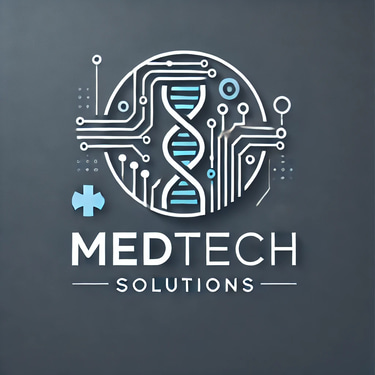Policy Highlights - The State of Medical Technology in Africa 2025: Opportunities & Challenges
This 2 pager Explores priority policy actions for 2025-2027 focusing on establishing medtech manufacturing hubs, regulatory harmonization for faster medical device approval, and developing a skilled biomedical engineering workforce to enhance healthcare innovation.
medtechsolns.com
11/20/20252 min read


Published by MedTechSolns.com — Policy & Innovation Series
Page 1
Executive Summary
Africa stands at a defining moment in the evolution of its medical technology ecosystem. As of 2025, the continent imports over 85% of all medical devices used in healthcare facilities, despite having the fastest-growing healthcare market globally (IFC, 2024). The combined pressures of population growth, rising non-communicable diseases, pandemics, and infrastructure gaps have exposed both critical vulnerabilities and unprecedented opportunities for transformation.
This policy brief provides senior decision-makers—government officials, regulatory authorities, medtech manufacturers, procurement agencies, healthcare engineers, and investors—with a strategic overview of the opportunities and challenges shaping Africa’s medtech landscape.
Current Landscape
1. Heavy Dependence on Imports
Most African countries rely on imported machinery for diagnostics, imaging, surgical equipment, consumables, and laboratory systems. This exposes health systems to:
Long procurement cycles
High equipment downtimes
Shortages of critical devices
Cost fluctuations
African hospitals report 40–70% of equipment being non-functional at any given time due to poor maintenance, lack of spare parts, and fragmented supply chains (WHO, 2023).
2. Regulatory Fragmentation
While the establishment of the African Medicines Agency (AMA) in 2021 marked progress, device regulation varies widely across African states. Lack of harmonization leads to:
Delayed approvals
Quality inconsistencies
Market entry barriers for innovators
In 2025, AMA continues working toward a unified device regulatory framework, but adoption is uneven.
3. Rising Local Innovation
Across Kenya, Nigeria, South Africa, Egypt, Rwanda, and Ghana, local medtech innovation hubs are emerging. Growth sectors include:
Low-cost diagnostic platforms
AI-powered radiology and pathology tools
Mobile health devices
3D-printed prosthetics
Point-of-care testing kits
However, many prototypes struggle to scale due to limited:
Manufacturing capacity
Capital investment
Clinical testing infrastructure
Market access pathways
Opportunities for Transformation
1. AfCFTA as a MedTech Market Catalyst
The African Continental Free Trade Area (AfCFTA) could unlock:
A $30+ billion unified healthcare market
Cross-border manufacturing
Medical device value-chain integration
Attractive regional hubs for global OEM partnerships
2. Local Manufacturing Acceleration
2025 brings renewed interest in shifting from assembly to full-scale manufacturing. Public-private partnership (PPP) models have shown viability, especially in:
Diagnostics manufacturing
PPE
Basic imaging
Consumables and surgical tools
Institutions such as AfDB, IFC, and Africa CDC have expressed intent to finance local medtech industrialization.
3. Digital Health & AI
AI-assisted diagnostic tools, remote monitoring devices, and telemedicine platforms are rapidly scaling. Africa’s uniquely young population (median age 19) offers a massive adoption base for digital-first medtech businesses.
Page 2
Key Challenges
1. Skills Gap
Africa faces shortages in:
Biomedical engineers
Device technicians
Calibration experts
Clinical research professionals
Without significant investment in technical training, device uptime, safety, and innovation will remain constrained.
2. Financing Constraints
Medtech ventures face high upfront costs and limited access to:
Early-stage capital
Equipment leasing models
Quality certification funding
Manufacturing financing
3. Hospital Infrastructure Gaps
Unreliable power systems, limited oxygen production, and insufficient space for advanced imaging equipment remain barriers to modernizing healthcare facilities.
Priority Policy Actions (2025–2027)
1. Establish Regional MedTech Manufacturing Hubs
Governments should designate Special MedTech Industrial Zones supported by:
Tax incentives
Export rebates
Subsidized power
Quality-certification programs
2. Implement Regulatory Harmonization via AMA
Accelerate adoption of the African Medical Device Harmonization Framework to shorten device approval from 3–5 years to under 12 months.
3. Develop Biomedical Engineering Workforce
Fund:
National biomedical engineering schools
Hospital-based maintenance fellowships
Device technician certification programs
4. Modernize Procurement Models
Move from “purchase-and-abandon” procurement to:
Lifecycle-based contracts
Leasing
Pay-per-use device models
OEM–hospital uptime agreements
5. Strengthen Local Clinical Trials Infrastructure
Build regional clinical research centers capable of testing:
AI diagnostic tools
Point-of-care devices
Imaging technologies
Wearables
This will increase investor confidence and accelerate export capacity.
Call to Action
Africa’s medical technology future depends on collaboration among governments, private investors, regulators, academic institutions, and global manufacturers. The next decade offers a rare opportunity to shift from dependency to self-reliance, innovation, and global competitiveness.
This brief serves as the first part of a multi-article series by MedTechSolns.com exploring Africa’s medtech transformation.
Stakeholders are invited to contribute insights, data, and partnerships to enrich this journey.
